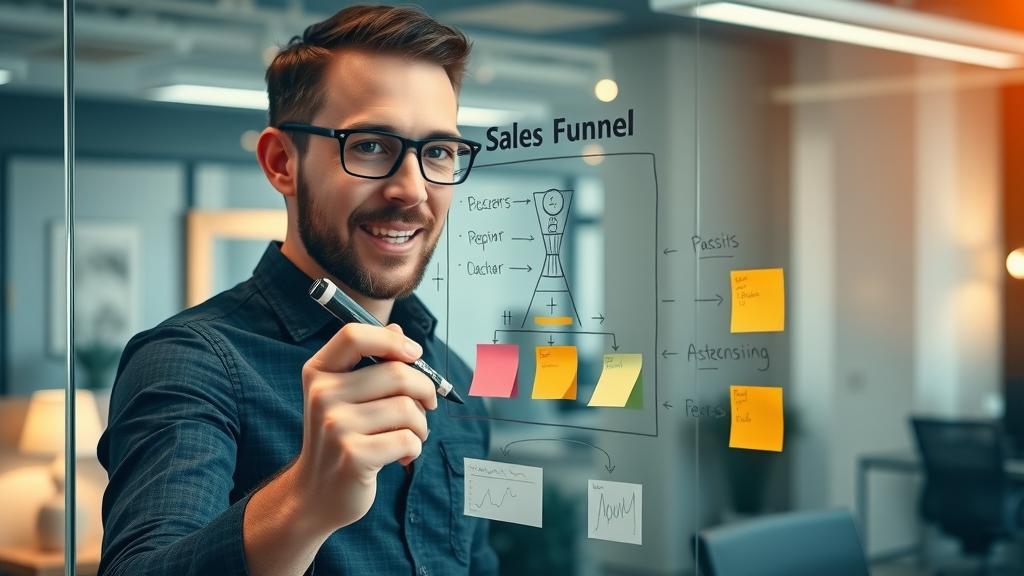Did you know that over 75% of companies using sales funnel automation see higher conversion rates within the first six months? In today’s fast-moving digital world, smart marketers rely on automated sales systems to outperform the competition, boost efficiency, and skyrocket results. This guide unpacks why now is the time to embrace sales funnel automation, the stages involved, essential tools, and actionable tactics straight from industry leaders. Whether you’re new to funnel automation or ready to level up, you’ll discover proven strategies to convert more leads, streamline your sales process, and grow your business—fast.
Why Sales Funnel Automation Matters Now: Surprising Data and Market Shifts
- Over 75% of companies using sales funnel automation report higher conversion rates within the first six months.
- Automated sales forecasting predicts a 40% reduction in customer acquisition costs for companies embracing automated sales funnels.
- The rise of AI-driven marketing funnel automation is quickly outpacing traditional sales funnels.
- Smart marketers achieve sustainable growth and scale operations far beyond manual processes.
As digital behavior evolves, the marketing funnel landscape is shifting dramatically. Consumers expect personalized, on-demand experiences. Brands that stick with manual processes risk falling behind, while competitors automate and accelerate every step of the customer journey. This shift is more than a trend—it's backed by hard numbers. Not only do automated sales funnels increase efficiency and conversion rates, but they also give sales teams the insights to fine-tune their approach in real time. If you want to remain relevant and effective, now is the time to invest in funnel automation .

Defining Sales Funnel Automation: Core Concepts and Strategic Benefits
What is sales funnel automation?
Sales funnel automation is the practice of using advanced technology and software solutions to automate repetitive tasks along every stage of your sales funnel . From lead generation and nurturing, to follow-ups and closing deals, automation tools reduce reliance on manual effort. With marketing automation, you create targeted workflows that deliver the right message to the right audience at the perfect time, boosting your conversion rate and empowering your sales team to focus on high-value activities.
By embracing sales funnel automation , organizations can optimize each step of the customer journey . Tasks like email campaigns, follow-ups, lead scoring, and reporting are managed automatically. This not only increases accuracy but allows marketing teams to nurture leads, qualify prospects, and move potential customers through the funnel with speed and consistency. The result: faster sales cycles, more loyal customers, and measurable growth.

Key Stages and Elements of the Automated Sales Funnel
| Stage | Description | Tools/Automation Examples |
|---|---|---|
| 1. Awareness | Attracting potential customer through content and outreach | Marketing automation, targeted ads |
| 2. Interest | Engaging visitors and capturing information | Landing page, email campaigns |
| 3. Consideration | Nurturing leads with relevant content | Email automation, personalized offers |
| 4. Intent | Motivating decision | Automated sales proposals, product demos |
| 5. Purchase | Conversion and onboarding | Payment automation, onboarding sequences |
What are the 5 stages of the sales funnel?
The five key stages of sales funnels begin with Awareness, where you draw the potential customer 's attention through smart content and targeted campaigns. The Interest stage engages the website visitor, often capturing their email address or other details through compelling landing pages. Consideration is about presenting value, nurturing leads, and building trust via email automation and relevant offers. The Intent stage signals a qualified lead is ready for a decision, so automated proposals, demos, or reminders tip the scale. Finally, the Purchase phase automates payment, onboarding, and the start of a loyal customer relationship—completing a streamlined, efficient marketing funnel .
Automation tools ensure that no lead falls through the cracks at any step. By using analytics to track engagement and trigger personalized actions, you can nurture leads into loyal customers while your sales team focuses on qualified prospects. Each phase is designed for velocity and results, enabling businesses to scale their sales process without overburdening staff or sacrificing personalization.

How Automated Sales Funnels Drive Effective Sales and Business Growth
- Efficient lead generation and nurture leads seamlessly through every funnel stage.
- Increased conversion rates through targeted email automation and personalized marketing automation tactics.
- Streamlined sales processes resulting in improved customer experience and faster deal closures.
- Insights from real-world smart marketers who accelerated performance using funnel automation.
Automating your sales funnel transforms the buyer journey, creating more qualified leads and accelerating time to close. Automated sales processes free up valuable hours, letting your sales team prioritize high-quality opportunities. By deploying targeted email campaigns at every step, businesses can maintain engagement, deliver convincing messages, and avoid letting good leads slip away.
Personalization powered by marketing automation tools further amplifies results. Instead of generic outreach, each potential customer receives content, offers, and follow-up tailored to their needs—driving higher conversion rates and turning prospects into loyal customers. Studies consistently show that companies using automated sales funnels outperform those relying solely on manual tactics, thanks to measurable insights and consistently optimized outreach.
"With automated sales funnels, our team closed 30% more deals in half the time, leaving us free to focus on scaling new markets." — VP of Growth, SaaS Provider
Components and Tools Used in Sales Funnel Automation
Landing page strategies for automated sales funnels
Landing pages are a cornerstone of every sales funnel . They capture the attention of your target audience and systematically convert visitors into leads. The key is to align every landing page with a specific stage in your funnel, using compelling calls-to-action, persuasive copy, and forms to collect contact information. Effective landing pages are tested and improved through ongoing A/B testing, analytics integration, and user feedback, ensuring that conversion rates rise over time.
Successful marketers harness integrated analytics and heat mapping tools to analyze visitor behavior, optimizing headline placement, form fields, and even color schemes. By continually refining your landing page strategy, you keep your funnels high-performing—and every lead captured becomes another opportunity to nurture.

Best marketing funnel automation software
There’s no shortage of platforms for sales funnel automation , but a few stand out for their features, scalability, and ease of use. HubSpot offers an all-in-one marketing automation suite—from lead generation, landing pages, and email sequence management, to deep analytics. ClickFunnels focuses on drag-and-drop funnel creation for every stage, while ActiveCampaign excels in advanced email automation and customer journeys. Keap (formerly Infusionsoft) is known for CRM and sales pipeline automation designed for small and growing businesses. Select a tool that matches your needs, size, and marketing campaign goals.
The best automated sales funnel solutions empower you to track, test, and optimize every aspect of your sales process. Whether you want deep segmentation, dynamic emails, or easy integration with your existing tools, modern platforms enable frictionless operation and fast results.
Integrating email automation and drip email campaigns
Email automation remains the backbone of effective sales funnels . Automated drip sequences nurture leads over time, delivering targeted email content and follow-ups as prospects take action within your funnel. From educational emails at the top of the funnel, to engagement-focused check-ins, to personalized offers—each touchpoint is delivered at the perfect moment, boosting the odds of conversion and keeping your marketing funnel “always on.”
With the help of automation, email campaigns never miss a beat. Each action by a lead—like signing up for a webinar or clicking on a product—triggers the next logical email. This type of hyper-relevant outreach builds trust, drives engagement, and dramatically increases conversion rate. Real-time reporting helps you refine your campaign and track which messages and sequences yield the best response from your target audience.
Advanced Marketing Automation: Leverage AI for Smarter Sales Funnels
- AI-driven lead scoring and dynamic segmentation for more relevant messaging.
- Automated split testing and behavioral triggers to capture high-intent potential customers.
- Machine-learning powered recommendations for real-time campaign improvements.
The biggest leap in sales funnel automation comes from AI and machine learning. By using intelligent lead scoring, you can instantly identify which leads are most likely to buy—saving time and allowing a laser focus on the right conversations. AI platforms dynamically segment your audience based on real behavior, triggering specialized content and offers that match their current stage in the buyer journey.
Machine-learning engines analyze massive datasets in the background, detecting patterns that may escape the human eye. They automatically run A/B tests, select winners, and tweak campaign flows. With these advances, your automated sales funnels steadily improve, capturing more conversions with less manual oversight and giving you a true competitive edge.

Best Practices and Common Mistakes in Funnel Automation
- Conduct thorough market research and understand your target audience before building your automated sales funnel.
- Regularly optimize landing page copy and design to improve conversion rates.
- Use analytics and A/B testing within marketing automation platforms for continuous results improvement.
- Avoid common pitfalls such as over-automation, generic email campaigns, and ignoring middle-of-funnel nurture leads.
The best automated sales funnel systems start with a deep dive into market research and the expectations of your ideal customer profile. Skipping this step leads to generic messaging and missed opportunities. Customizing your funnel automation to the needs, pain points, and preferences of your target audience sets the stage for high conversion rates and loyal customers.
Optimization is never a one-and-done affair. Monitor analytics closely; run regular A/B tests on your landing pages, subject lines, and offers; and adjust your workflows based on real customer data. A common mistake is leaning too heavily on automation—your messaging must remain human and personal, even when powered by technology. Continuous improvement and authentic communication are non-negotiable for smart marketers seeking to stay ahead.

Real-World Examples: Automated Sales Funnels in Action
eCommerce: Driving sales with automated customer journeys
Leading eCommerce brands rely on automated sales funnels to nurture leads from the first click to loyal customer status. For example, after a customer visits your website and browses specific products, an automated workflow can send targeted emails featuring similar items, reminders about abandoned shopping carts, or time-limited discounts. These triggered, personalized offers keep the brand top-of-mind and drive shoppers back to complete their purchase, boosting the overall sales conversion rate.
Automation also helps build loyalty post-purchase. Welcome sequences, satisfaction surveys, and exclusive first-access launches delivered via automated email campaigns delight new customers and can transform one-time buyers into repeat, high-LTV clients. This level of personalization at scale is simply not possible with manual outreach.

B2B: Shortening sales cycles with marketing funnel automation
B2B companies often face complex, lengthy buying cycles. By integrating marketing automation with CRM tools, sales teams can automate sequential content delivery, trigger sales tasks at the right moments, and keep prospects engaged throughout the journey. For example, when a decision maker downloads a whitepaper, an automated workflow can immediately assign a salesperson to follow-up, send a relevant case study, or schedule a demo—keeping the momentum high and reducing time-to-close.
Smart B2B sales teams supplement automation with strategic personal touches where necessary, but rely on technology for consistency, analytics-driven decision making, and scaling their efforts to reach many prospects without burning out staff. This hybrid approach transforms the efficiency and output of complex pipelines, ensuring every qualified lead is engaged at the right time with the right information.

People Also Ask: Insights into Sales Funnel Automation
What is sales funnel automation?
Sales funnel automation is the process of using digital tools and software to automate and optimize every stage of a sales funnel, from lead generation and nurturing, to closing deals. It replaces manual tasks with strategic workflows, boosting efficiency and results for any sales team or marketer.
What are the 5 stages of the sales funnel?
The five stages are: Awareness (attracting leads), Interest (engaging and educating), Consideration (presenting solutions), Intent (motivating buyer decisions), and Purchase (closing the sale and onboarding the new loyal customer).
What is the best sales funnel software?
Top-rated automated sales funnel software includes ClickFunnels , HubSpot , ActiveCampaign , and Keap . These platforms lead the way with robust marketing automation , email campaigns , and in-depth analytics—all designed to streamline funnel automation and increase conversions.
Do sales funnels really work?
Well-optimized sales funnels , especially those driven by automation, reliably convert leads to customers. Leading marketers consistently see higher ROI, streamlined processes, and increased revenues from automated sales funnel strategies—and the results are proven across industries.
Watch a breakdown of how sales funnel automation supercharges the customer journey , increases lead generation , and drives sales for modern businesses.
Frequently Asked Questions about Sales Funnel Automation
Is sales funnel automation suitable for small businesses?
Absolutely. Even small businesses can leverage affordable marketing automation tools to gain a competitive edge, nurture leads, and increase sales efficiently. Entry-level platforms offer user-friendly features and powerful automation for businesses of every size.
How do I know which stage of my automated sales funnel needs fixing?
Use analytics and reporting tools to identify drop-off points and low-performing campaigns. Focus on the stages with the largest drop in conversion rates or where leads frequently disengage—these are your best opportunities for improvement.
How often should I update my funnel automation workflows?
Review and optimize your workflows at least quarterly, or whenever shifts in your target audience , offers, or sales goals occur. Regular updates keep performance strong and your automation aligned with current business needs.

Next Steps: Start Building Your Automated Sales Funnel Today
- Assess your current sales funnel and pinpoint automation opportunities.
- Choose the right funnel automation software tailored to your business needs.
- Design engaging landing pages and personalized email campaigns to nurture leads.
- Use analytics to track, test, and optimize every stage of your sales funnels for continuous growth.
"The sooner you automate, the sooner you scale. Sales funnel automation is the engine behind the top smart marketers' success." — Digital Marketing Expert

Take Control of Your Growth with Sales Funnel Automation
Ready to grow your business and connect with more customers? Book your free marketing strategy with our team today. Call: 314-560-4642 or visit: https://marketingconnectionsllc.com/get-in-touch
Actionable Next Step: Audit your existing sales funnel, select a reliable automation platform, and implement at least one new workflow this week to experience immediate growth benefits.
To deepen your understanding of sales funnel automation, consider exploring the following resources:
-
“Automated Sales Funnel: Step-By-Step Guide for Marketers” ( mountain.com ) offers a comprehensive walkthrough on building and optimizing automated sales funnels, covering essential stages and best practices.
-
“Automated Sales Funnels: Improve Your Lead Conversion Rate” ( callpage.io ) provides insights into enhancing lead conversion rates through automation, detailing strategies and tools to streamline your sales process.
These articles provide actionable strategies and insights to help you implement and refine your sales funnel automation efforts effectively.
 Add Row
Add Row  Add
Add 






Write A Comment